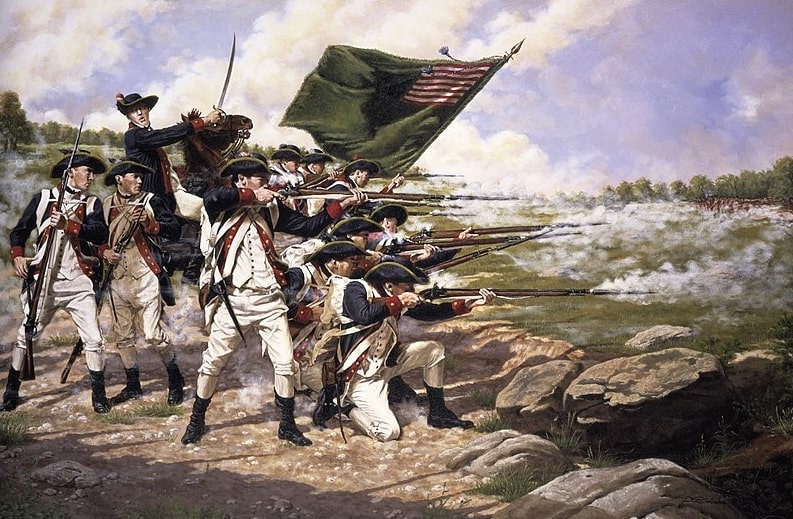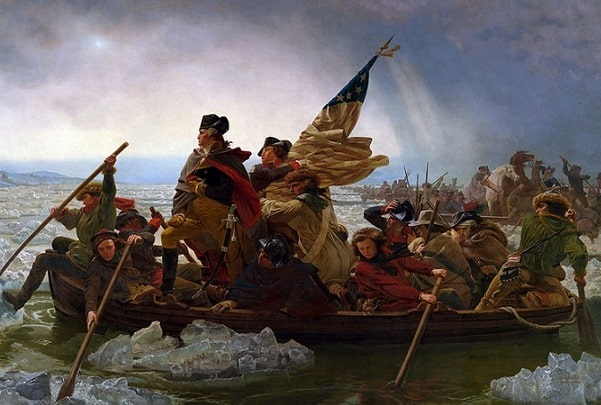The Revolutionary War was the founding of a nation and the beginning of the Great Experiment. Embracing the ideals of liberty and equality for all, Americans under George Washington and the rest of the Founding Fathers fought for their freedom against the tyrannical British King George III.
Everyone learns the basic facts about the origins of the U.S. in school. Iconic battles and heroic figures aside, there are many fun facts about the Revolutionary War that aren’t as well known.
Here are 10 facts about the Revolutionary War you probably haven’t heard before.

10 Interesting Facts about the Revolutionary War
Fun facts about the American Revolution can tell us a lot about the values that came to define this country. Yet as with any war, facts usually revolve around the countries involved and more general knowledge. However, wars are fought by people, and we believe those facts are the most important ones. Check out these 10 Revolutionary War facts for a look at the people behind the scenes.
1) The British Planned to Assassinate George Washington
One of the most interesting American Revolution fun facts is that the uprising almost failed before it began. Before the Declaration of Independence was even signed, a secret committee uncovered an assassination plot against George Washington, devised by the British and operated by many American sympathizers – including Thomas Hickey, Washington’s personal bodyguard.
Although people like the governor of New York and the mayor of New York supported the plan, only Hickey was executed for the plot. What’s most interesting is that the secret committee that uncovered the plot formed the earliest incarnation of what morphed into the modern-day CIA.
2) Women Fought in the Continental Army
A small number of women fought in the Continental Army. The most prominent woman to fight was Deborah Sampson, who disguised herself in male clothing. Masquerading as Robert Shurtleff, she fought for two years, was injured multiple times, and was considered an effective soldier.
Sampson was discovered in 1783 and honorably discharged after being sent to the hospital for treatment. After the war, she wrote a memoir in 1797 and toured the country telling her story. An interesting fact about the Revolutionary War is that Congress awarded her with a soldier’s pension, but only after a petition from her husband.
3) Paul Revere and Dental Forensics
Paul Revere is most famous for his Midnight Ride to inform the Patriots of the coming of the British. Yet he was also a talented silversmith whose hobby was dentistry. As the war continued, he was asked to identify a badly decomposed body of a fallen soldier. He checked the man’s mouth to see if the ivory teeth matched Revere’s work as part of his side hustle. Historians believe it was the first instance of a body being identified using dental forensics.
4) Hostilities Didn’t Cease in 1781
Every American growing up is told that fighting in the American Revolution ended after the Surrender at Yorktown in 1781. Despite the surrender in Virginia and the exit of the British, peace did not come to the Thirteen Colonies.
Just one year later in 1782, British sympathizers arose in many parts of North America. South Carolina was especially brutal, seeing increased conflict, with warring civilians burning homes, barns, and laying claim to each other’s lands. It took some time before the violence ceased as the victorious Continental Army marched into South Carolina to enforce peace.
5) Messages Were Communicated with Invisible Ink
Lesser-known Founding Father John Jay’s brother was Doctor James Jay. Dr. Jay created an invisible ink out of ferrous sulfate mixed with water during the war. This substance could be used to write secret messages. After the ink dried, nothing could be seen. The paper needed to be covered in a revealing chemical or placed close to a heat source to reveal the message. George Washington and his commanders used it to disguise messages between the lines of letters, newspaper clippings, or in the backs of books.
6) The Second Midnight Ride
While Revere’s Midnight Ride is the most famous, a second one occurred just two years later. Sybil Ludington, aged 16, rode from 9 p.m. until dawn to tell the New York militia of the burning of Danbury in Connecticut. One of the other fun facts about the Revolutionary War is that Revere didn’t complete his Midnight Ride alone. An estimated 40 men participated.
7) Pirates at Sea
The Continental Congress was fervent in its patriotism. Unfortunately, what they lacked was money. While the French, Spanish, and Dutch would counterbalance the might of the British Royal Navy later in the war, the Patriots needed their own solution. One of the most interesting facts about the Revolutionary War is that the Continental Congress hired pirates, known as privateers, to attack British shipping. The agreement was that they would have to split the booty with the Continental Congress. Whether that happened has been lost to time.
8) The Reality of George Washington
Despite the legends surrounding George Washington, he was not a particularly effective general – despite his history of serving in the British Army. Much of the early war was marked by the Patriots’ defeat after defeat, with the opening engagement of the Battle of Bunker Hill being a particular failure.
The defeat in 1776 at the Battle of Long Island nearly saw Britain win the war by occupying New York City. Only the lack of initiative from General Howe on the British side gave Washington the chance to regroup and launch a counterattack.
Washington also didn’t have wooden teeth. His teeth were made from cow’s teeth and ivory held together by springs.
9) War Was Not Inevitable
The Second Continental Congress tried to reconcile with King George III months after the Revolution started in 1775. One of the little-known, interesting facts about the American Revolution is that many colonists loved Britain and the king. Even after the outbreak of war, a considerable portion of the country was committed to the Loyalist cause. Most historians believe that no more than 45% of the colonists were committed Patriots during the Revolutionary War. About a third of the colonists fought on the British side.
Known as the Olive Branch Petition, the Second Continental Congress hoped to avert war at the last minute. Only a small group of Patriots, led by John Adams, disagreed with the move. King George III, however, refused to read the petition, and, from that point, the American Revolution entered full flow.
10) 200 Copies of the Declaration Were Printed
Fun facts about the American Revolution don’t usually mention that there were actually 200 copies of the original Declaration of Independence printed. When most people think of the original, they think of the one preserved at the famous National Archives in Washington, D.C. While this is the only original copy with all of the signatures of the Founding Fathers, there are actually multiple originals still around today.
John Dunlap, a printer who started his career at the age of 10 in Philadelphia, printed a total of 200 original copies of the Declaration of Independence. Only one (the one in the National Archives) has all 56 signatures of the Second Continental Congress, but the other 199 were officially signed by John Hancock and Charles Thompson. Today, 26 of those originals are accounted for, while the rest have been lost to the centuries.
Honor Your Family History with Genealogy Bank
These fun facts about the Revolutionary War cast a light on the thousands of brave individuals involved in the Revolutionary War. Fun facts like these reflect how the decisions of the men and women on both sides changed the course of history. Those echoes continue to define the American mindset today.
Discovering your family history can help you find a sense of deep history and belonging in this brave country. GenealogyBank contains the most extensive set of newspaper archives dating back more than 300 years. Search obituaries online and start your journey through history by creating your free account with GenealogyBank today.
Note on the header image: “Washington Crossing the Delaware” by Emanuel Leutze, 1851. Credit: The Metropolitan Museum of Art; Wikimedia Commons.
